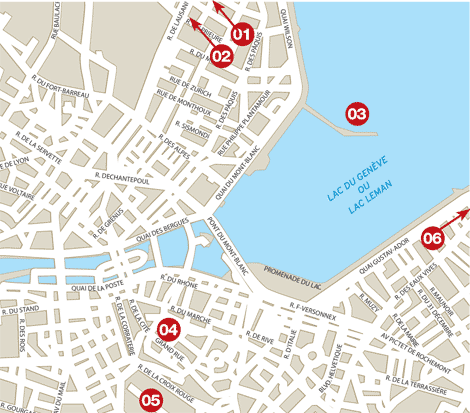Geneva is known for its luxury watches and chocolate. But Felicity Cousins saves her pennies and her waistline and finds more to explore, from the United Nations to the city's 'Beverly Hills', not forgetting the city's lakeside setting

1. United Nations Office at Geneva (UNOG)
Start on the north side of the lake. Geneva is home to the headquarters of more than 200 international organizations and is probably most famous for the main European offices of the United Nations. The organisation is based in the Palais des Nations, which was built in the 1930s to house the League of Nations and is twice the area of Versailles. You can take a one-hour tour to see the meeting and conference rooms where some of the most important decisions in history have been made. Winter opening times are from 1000-1200 and 1400-1600 (until March). Palais des Nations,18 avenue de la Paix, tel +41 22 917 48 96, unog.ch. Admission CHF10 (£4.15). But if empty rooms don't excite you, head to the Red Cross Museum instead.
2. International Red Cross Museum
Opposite the United Nations, up a small hill (through a bunker passage) is the International Red Cross and Red Crescent Museum. The Red Cross was founded in 1863 by a Swiss, Henri Dunant, and the museum takes you through a visual history depicting the work the organisation has done to help innocents during the world's wartime atrocities. When I was there the temporary exhibition was on the Cambodian genocide (1975-1979), when 1.7 million Cambodians were murdered by Pol Pot and the Khmer Rouge. Outside the museum is a group of stone people bound and blindfolded, representing the continuing human rights atrocities across the globe. It is a moving place. Located at 17 avenue de la Paix, tel +41 22 748 95 25, micr.ch. Open 0900-1700 (except Tues). Entrance CHF10.
3. Bains des Paquis
Take a bus or taxi along the shore of the lake towards the city centre to Jetée des Pâquis Bains. This is the local place to lunch and swim. For the "cheapest lunch in town" you can sit at the blue tables on the waterside and have a main course for CHF10 (in winter fondu is served inside the café). The lake is clear; you can see the bottom even in the centre of town where all the large hotels and banks are. This is partly because 25 years ago soaps with phosphate in them were banned in order to protect the purity of the water. Now the Swiss need to persuade the French and the tourists to do the same. From the jetty you will also have a good view of the 140m Jet d'Eau (pictured left) - visible on almost every postcard of Geneva.
4. The Old Town
Walk along the lake towards the centre and cross over Ponts de l'lle to reach the Old Town. It is a steep walk up to the centre to the Cathédrale Saint Pierre but the narrow cobbled streets are picturesque, housing boutique shops and bars. I found Le Cave de Palais, a cavern-like shop with more than 300 different whiskeys and wines from all over the world, including many local varieties such as Gamet (closed on Mondays). The Cathédrale Saint Pierre was built between 1160 and 1232 and is famed for being the scene of Calvin's triumph when it became a Protestant church in 1536, with Calvin's followers tearing out the altar, paintings and statues. Here you can still see Calvin's chair. You can climb the 157 steps to the top for views but I chose to wander down to Geneva's oldest square, Place du Bourg-de-Four. It is thought this was once a Roman forum and it is a good place to stop for a snack in one of the outdoor café.
5. Reformation Monument
In1909 (the 400th anniversary of John Calvin's birth), the city raised a monument to the founders of the Protestant Reformation movement.Standing in the Parc des Bastions, in the heart of the city, the Reformation Monument is a 100m-long granite wall decorated with bas-reliefs depicting key events, from the beginning of the Reformation in 1536 up to 1602. In the centre of the wall are four statues of the leaders of the Reformation: John Calvin, John Knox, William Farel and Theodore de Bèze. The motto of the Reformation and of the city - "Post Tenebras, Lux" (After Darkness, Light) - flanks them. Parc des Bastions was the city's original Botanical Garden, founded in 1817 next to the old town, and today still boasts more than 50 rare varieties of trees.
6. 'Beverly Hills of Geneva': Cologny
If you have time, take a bus from the city centre 6km north-east (Bus A) to the exclusive leafy suburb of Cologny. Known as the Beverly Hills of Geneva, this is where the real money lies, with impressive houses scattered along the hillside. It was also where Byron and Milton once stayed to write, and on Chemin de Ruth stands Villa Diodati, where Percy and Mary Shelley stayed in 1816. The story goes that during weeks of bad weather in "the year without a summer" the poets challenged each other to pen a horror story, and so Mary Shelley wrote Frankenstein. The house looks out over the lake, and you can almost imagine the thunder pealing and the lightning crackling as Frankenstein's monster was born.








